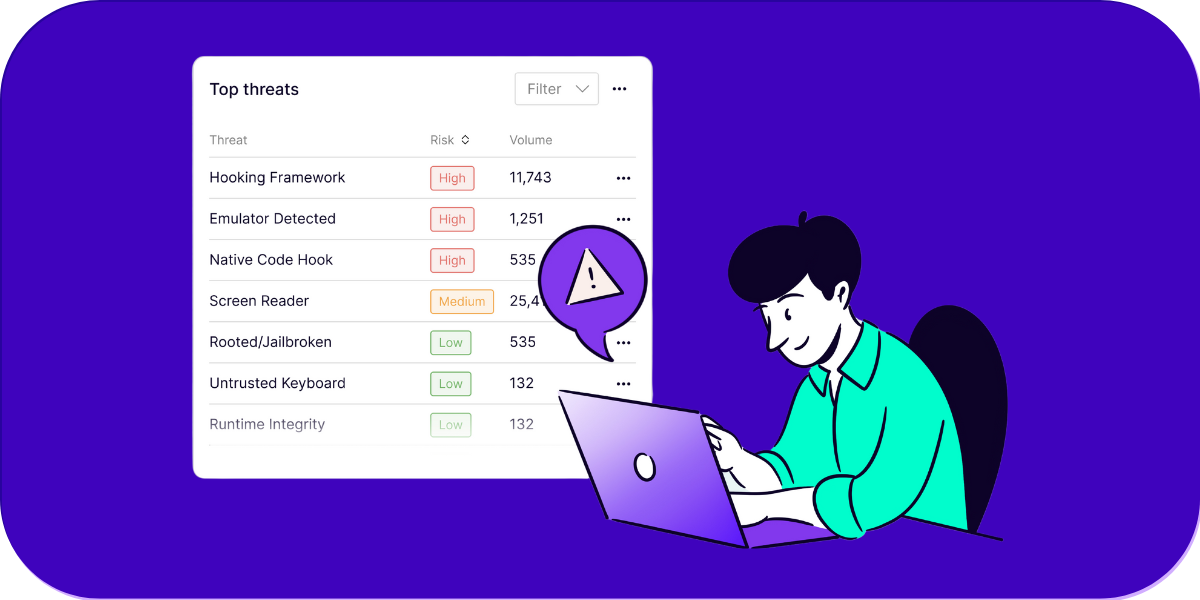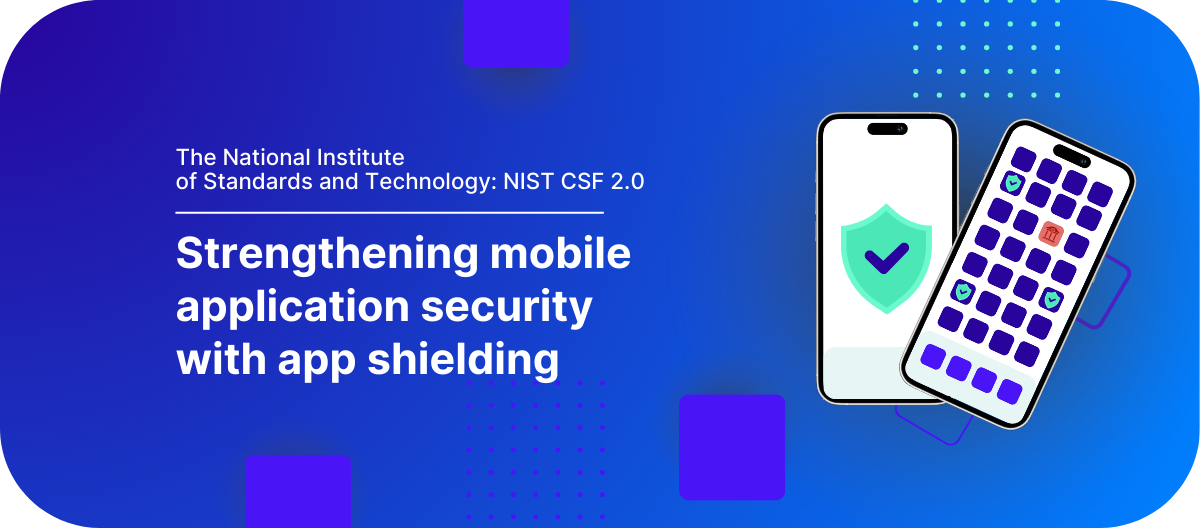From actionable security insights to calculating your bottom line, the right data makes all the difference. Here’s how to make the most of your analytics.
You poured countless hours and resources into securing your mobile app, but how do you know if it's paying off? Are you just throwing money into a black hole, or are your investments actually protecting your business and your customers?
The truth is: without solid data, you're flying blind. You might think your app is secure, but you need numbers to back it up. And mobile app security analytics can help with this. It's the key to understanding the real impact of your security efforts and making data-driven decisions that move the needle for your business.
The elusive nature of mobile app security ROI
Measuring the return on your mobile app security investments can feel like trying to catch smoke. You can count the number of threats blocked or vulnerabilities patched, but those metrics don't always resonate with non-technical stakeholders.
Imagine this: you're the Chief Information Security Officer (CISO) and oversee your organization's information and cybersecurity. You're presenting your quarterly security report to the executive team and proudly highlight that your team blocked 10,000 potential threats over the last quarter. The CEO nods and smiles, but you can see the question forming behind their eyes: "That's great, but what does it actually mean for our bottom line? How does it impact revenue?"
This disconnect between security metrics and business outcomes is a common challenge. Without a clear link to financial impact, your security efforts can be seen as a necessary evil rather than a strategic investment. Here’s how to pitch mobile app security so when budgets get scrutinized, your initiatives do not end up on the chopping block.
Embracing data-driven security
In cybersecurity, data is the difference between guessing and knowing, between hoping and proving. With a data-driven approach to mobile app security, you can:
- Prioritize threats intelligently: Not all security alerts are created equal. Some are false positives, while others indicate critical vulnerabilities. Analytics help you cut through the noise and focus on the threats that pose major risks to your business.
- Identify anomalies proactively: To detect threats, you first need to understand what “normal” looks like for your app. Cybersecurity analytics allow you to establish baselines for user behavior, network traffic, and system performance. With these baselines in place, you can quickly spot deviations that could signal a potential attack. For example, a sudden spike in screen recordings from a specific geography could indicate a malware attack that needs investigation and mitigation.
- Quantify the impact of your efforts: How do you measure the impact of an attack that never happened? Analytics provides the answer. By tracking the number and severity of incidents prevented, the potential financial damage avoided, and the time saved in incident response, you can put a dollar value on your security efforts.
- Optimize your security posture continuously: Threats evolve, technologies change, and new vulnerabilities emerge every day. To stay ahead of the curve, you need to continuously assess and optimize your security posture. Analytics give you the insights you need to identify areas for improvement, measure the effectiveness of your controls, and make data-driven decisions about where to focus your efforts.
The need for evidence-backed data
Real time, or near-instant data is crucial for cybersecurity. When cyber criminals probe for weaknesses constantly, threats emerge and escalate rapidly. Relying on weekly or monthly security reports leaves you vulnerable to emerging threats. Without evidence-based insights, security teams may make uninformed decisions.
Mobile threat analytics are important for compliance with data protection regulations like GDPR and CCPA with strict requirements around timely data breach reporting.
Key metrics for quantifying mobile app security ROI
To effectively measure the ROI of your mobile app security efforts, you need to focus on metrics that tie directly to business outcomes. Here are some key areas to consider:
- Risk reduction: By tracking metrics like the number of incidents prevented, the severity of vulnerabilities patched, and the time to detect and respond to threats, you can quantify the reduction in risk achieved by your security investments. For example, if you implement a new mobile app security solution and see a 50% reduction in successful attacks, that's a powerful indicator of ROI.
- Cost avoidance: According to IBM's Cost of a Data Breach Report 2024, the average cost of a data breach is $4.88 million. To quantify the potential costs you avoid by preventing incidents, estimate the financial impact of various attacks (e.g., data breaches, system downtime, and reputational damage) and track how many of these your security measures prevent. For example, if your mobile app has 1 million users and you prevent a data breach that could affect 10% of them, you can calculate the potential cost savings based on the average cost per record.
- Operational efficiency: Effective mobile app security measures don’t just prevent incidents but efficiently manage and monitor your security posture. Using mobile app security analytics tools for telemetry data analysis can streamline your security operations. This data-driven approach leads to significant time and cost savings, enhancing the overall efficiency of your cybersecurity efforts.
- Customer trust and loyalty: Recent data shows that 67% of smartphone users worry about data security and privacy on their devices. A single data breach can shatter trust and drive customers away in droves. By measuring the impact of your security efforts on customer sentiment, you can demonstrate the ROI of protecting your brand reputation. Metrics to track could include customer satisfaction scores, app store ratings, and customer lifetime value. For example, if you communicate a major security upgrade to your users and see a 10% increase in app engagement and a 5% increase in customer retention, that's a clear indicator of the business value of security.
Benchmarking against industry standards
To truly understand your cybersecurity posture, you need to benchmark your program against industry standards and best practices. This allows you to:
- Identify gaps and prioritize improvements: Investments in cybersecurity can be scaled almost indefinitely, making it challenging to determine when you have achieved a balanced and appropriate level of security in your mobile apps. Using regional and industry benchmarks on mobile security posture and threat activity volumes help security teams understand their exposure relative to the market. This insight enables them to make informed investment decisions, guided by standards like NIST and the OWASP MASVS.
- Align with regulatory requirements: Industry benchmarks and insights into the current threat landscape help you better align your cybersecurity programs with specific regulatory requirements like PSD for payment services or HIPAA for protected health information. Understanding your exposure relative to industry standards helps determine whether more or less investment is needed to comply with these regulations. This approach ensures you meet your compliance obligations effectively while avoiding potential fines and legal liabilities.
- Demonstrate due diligence to stakeholders: In the event of a security incident or regulatory investigation, being able to show that you've aligned your program with industry standards can be a powerful defense. It demonstrates that you've made a good-faith effort to protect your customers' data and your company's assets. This can help mitigate legal and reputational risks.
The road ahead: Leveraging analytics for mobile app security success
Mobile app security analytics is about giving you the data you need to make informed decisions, prove your value, and keep your mobile app secure in a constantly changing threat landscape.
By focusing on metrics that matter to your business, leveraging near-real-time data, and benchmarking against regional and industry standards, you can quantify the ROI of your mobile app security efforts and show that you're not just a cost center, but a critical enabler of business success.
The road ahead may be challenging, but with the right data, the right tools, and the right mindset, you can build a mobile app security program that is not only effective but also a true competitive advantage. And that's an ROI that any business can get behind.
Ready to supercharge your mobile app security with the power of analytics? Check out Promon Insight™, the advanced app security analytics solution built specifically for mobile apps. With near-real-time threat detection, flexible configurations, and easy integration with your existing tools and processes, Promon Insight™ gives you the visibility and control you need to protect your app, your users, and your business. Speak to a Promon expert today to learn more.




